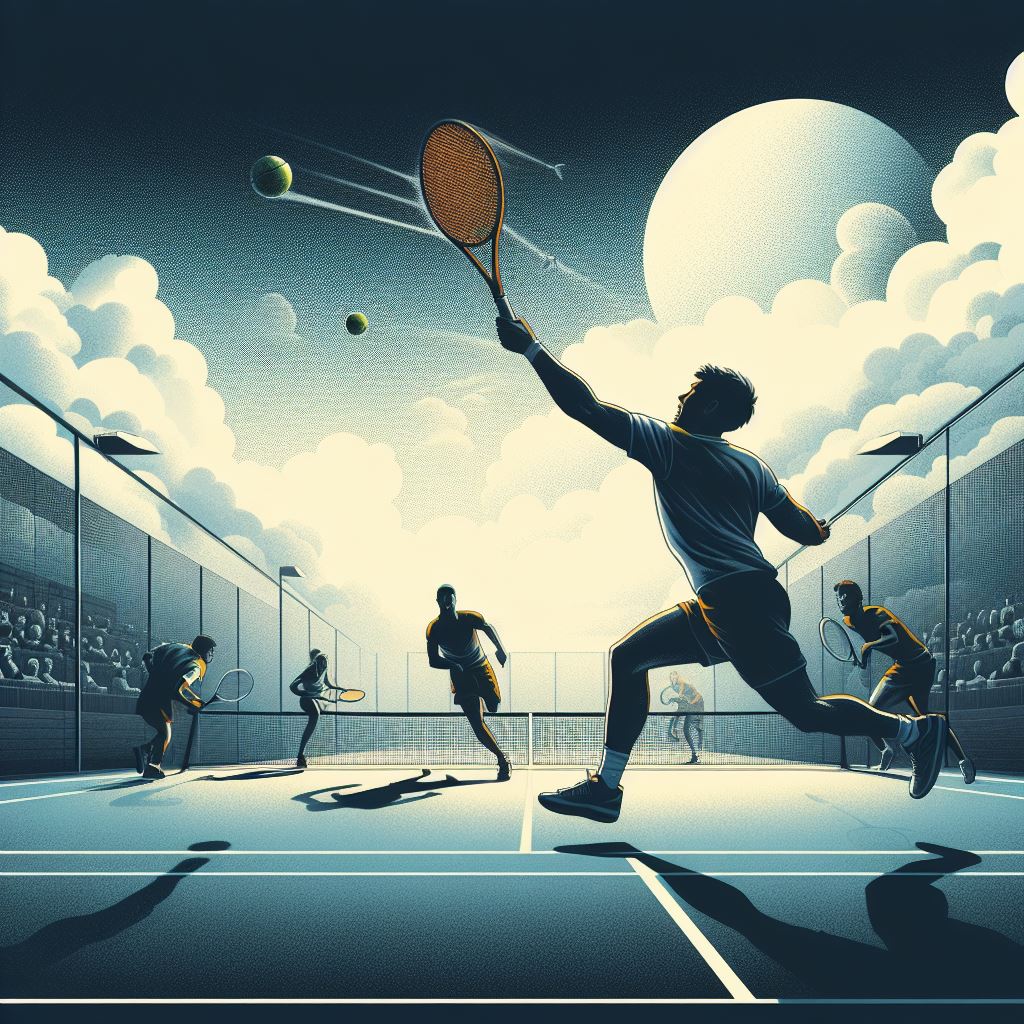In the thrilling world of tennis, hard court matches demand not only skill and athleticism, but also strategic finesse.
This article unveils a collection of hard court strategies for the avid player seeking fast-paced wins.
From mastering the art of the Aggressive Serve to implementing tactical shot placement and developing a strong net game, these techniques will equip you with the tools necessary to emerge victorious on the unforgiving surface.
Prepare to elevate your game with these tried-and-true methods.
Key Takeaways
- Aggressive serves with power and accuracy are essential for fast-paced wins on hard courts.
- Quick footwork and agility are important for reacting to opponents and creating openings.
- Strategic shot placement, such as deep baseline shots and cross-court shots, can control the game and create advantages.
- Developing a strong net game through efficient volleys, precise footwork, and fast reflexes can help dominate the net and win points.
Mastering the Aggressive Serve
The aggressive serve is a crucial weapon in a player’s arsenal for achieving fast-paced wins on hard courts. It is a strategic move that requires both power and accuracy to be effective. Perfecting power in the serve involves generating maximum speed and force to make it difficult for the opponent to return the ball. This can be achieved through proper technique, strength training, and efficient body mechanics.
A strong and explosive serve can put the opponent on the defensive right from the start, giving the server an advantage in the game.
Enhancing accuracy is equally important in the aggressive serve. Hitting the serve with precision ensures that it lands in the desired location on the court, making it harder for the opponent to return. This requires a combination of focus, practice, and control. Players must develop the ability to consistently place the ball in specific areas, such as the corners or the lines, to maximize their chances of winning points.
To master the aggressive serve, players should focus on both power and accuracy. They must train their bodies to generate maximum force while maintaining control over their shots. Regular practice and repetition are essential in developing the necessary skills and muscle memory.
Utilizing Quick Footwork
Utilize quick footwork to gain an advantage in fast-paced hard court matches. Improving agility and reaction time is crucial in order to respond swiftly to your opponent’s shots. By honing your footwork skills, you can position yourself optimally to reach the ball and execute your shots effectively.
One technique to enhance your footwork is to utilize deceptive footwork techniques. By employing deceptive movements, such as quick direction changes or sudden stops, you can confuse your opponent and create openings for attacking shots. Incorporating feints and stutter steps can also keep your opponent guessing and off balance.
To improve your agility, focus on drills that require quick changes of direction and lateral movements. These exercises can help you develop the ability to move swiftly and effortlessly across the court. Additionally, practicing split-step timing can enhance your reaction time, allowing you to anticipate your opponent’s shots and respond more effectively.
Maintaining a balanced and low stance is also essential for quick footwork. By keeping your center of gravity low, you can quickly shift your weight and change direction without wasting precious time.
Implementing Tactical Shot Placement
When implementing tactical shot placement in fast-paced hard court matches, it is imperative to strategically position the ball using precise and strategic aim. Precision and accuracy in shot selection are crucial in order to gain an advantage over the opponent and control the flow of the game. Understanding the importance of court positioning is also key to executing effective shot placement.
To engage the audience and provide a visual aid, the following table demonstrates different shot placements and their strategic advantages:
| Shot Placement | Strategic Advantage |
|---|---|
| Deep Baseline | Forces opponent to move back and defend |
| Cross-Court | Opens up angles for winners |
| Down the Line | Shortens the distance for the opponent |
| Drop Shot | Catches opponent off guard, disrupts rhythm |
By strategically placing shots deep into the baseline, players can force their opponents to move back and defend, creating opportunities to control the point. Cross-court shots can open up angles for winners, allowing players to hit shots that are difficult for opponents to reach. Hitting shots down the line shortens the distance for the opponent, making it harder for them to defend effectively. Finally, a well-executed drop shot can catch the opponent off guard and disrupt their rhythm.
Developing a Strong Net Game
To enhance performance on hard courts, players must focus on developing a formidable net game. Mastering the skill of efficient volleys is crucial for dominating the net and putting pressure on opponents.
Here are three key elements to consider when developing a strong net game:
- Footwork: Quick and precise footwork is essential for getting into position to hit efficient volleys. Players should practice split-step timing and explosive lateral movements to react swiftly and cover the net effectively.
- Anticipation: Anticipating your opponent’s shots can give you a significant advantage at the net. By studying their patterns and body language, you can predict where they are likely to hit the ball, allowing you to position yourself optimally and make successful volleys.
- Reaction time: Developing fast reflexes is crucial for a strong net game. Players should train their reaction time by practicing drills that involve quick volleys and rapid directional changes. This will enable them to respond promptly to their opponent’s shots and maintain control at the net.
Maintaining Mental Toughness
A player’s mental toughness is essential for maintaining a strong net game and dominating opponents on hard courts. Building resilience and managing performance pressure are two key aspects of maintaining mental toughness in tennis.
Building resilience is crucial for withstanding the challenges and setbacks that can occur during a match. Tennis is a mentally and physically demanding sport, and players must learn to bounce back quickly from mistakes or losses. Developing mental resilience involves cultivating a positive mindset, staying focused on the present moment, and maintaining confidence in one’s abilities.
Managing performance pressure is another important aspect of maintaining mental toughness. The pressure to perform at a high level can be overwhelming, but players who can effectively manage this pressure are more likely to succeed. Strategies such as deep breathing, visualizing success, and focusing on the process rather than the outcome can help players stay calm and composed under pressure.
Frequently Asked Questions
What Are Some Common Mistakes to Avoid When Executing an Aggressive Serve on a Hard Court?
When executing an aggressive serve on a hard court, it is important to avoid common mistakes that could hinder your success. These mistakes may include improper grip, lack of power, poor timing, and failure to utilize the correct technique.
How Can I Improve My Footwork to Effectively Respond to Fast-Paced Shots on a Hard Court?
Improving footwork is crucial for effectively responding to fast-paced shots on a hard court. Incorporating footwork drills and anticipating shots can enhance agility, positioning, and reaction time, enabling players to adapt swiftly and gain an edge in fast-paced matches.
Are There Any Specific Shot Placement Strategies That Work Best on Hard Courts?
Shot selection and court positioning are crucial strategies for winning on hard courts. By carefully choosing where to place your shots and maintaining optimal court positioning, you can maximize your chances of success in fast-paced matches.
What Are Some Key Techniques to Develop a Strong Net Game on a Hard Court?
Developing strong net game on a hard court requires mastering volley skills and employing effective net positioning techniques. By honing these techniques, players can dominate the net, putting pressure on their opponents and increasing their chances of fast-paced wins.
How Can I Enhance My Mental Toughness to Stay Focused and Perform Well During Fast-Paced Matches on a Hard Court?
Developing mental resilience and maintaining focus under pressure are essential for performing well in fast-paced matches on a hard court. Strategies such as visualization, positive self-talk, and mindfulness can enhance these mental skills.
Conclusion
In the fast-paced world of hard court tennis, mastering the aggressive serve, utilizing quick footwork, implementing tactical shot placement, developing a strong net game, and maintaining mental toughness are crucial strategies for achieving victory.
By employing these techniques, players can create a visual symphony on the court, with their serves whizzing past opponents, their feet dancing across the surface, their shots landing precisely where they intend, and their net play dominating the game.
Success on the hard court requires a strategic approach that combines skill, agility, and a steely resolve.








No Comment! Be the first one.